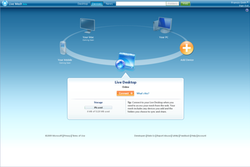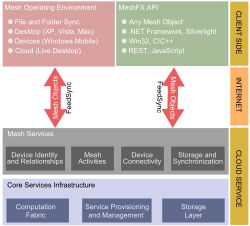Live Mesh: Difference between revisions
No edit summary |
Undid revision 296714632 by 217.23.232.41 (talk) no, it wasn't ever |
||
| Line 15: | Line 15: | ||
}} |
}} |
||
''' |
'''Live Mesh''' is a [[data synchronization]] system from [[Microsoft]] that allows files, folders and other data to be shared and synchronized across multiple devices.<ref name="everything">{{cite web | title = Live Mesh: it’s everything we told you about (and a lot more) | publisher = LiveSide | accessdate = 2008-04-23 | url = http://www.liveside.net/blogs/main/archive/2008/04/23/live-mesh-it-s-everything-we-told-you-about-and-a-lot-more.aspx }}</ref> Once a folder is set for synchronization, it will be available in all devices, and any changes made to the content of the folder will be reflected across all devices.<ref>{{cite web | url = http://www.liveside.net/blogs/main/archive/2008/04/23/live-mesh-technology-preview-first-look.aspx | title = Live Mesh Technology Preview: First Look | publisher = LiveSide | accessdate = 2008-04-23}}</ref> Live Mesh uses [[FeedSync]] to convey the changes made in each device so that the changes can be synchronized.<ref>{{cite web | url = http://www.liveside.net/blogs/opinion/archive/2008/04/23/ray-ozzie-on-live-mesh-there-s-almost-nothing-there.aspx | title = Ray Ozzie on Live Mesh: “There’s almost nothing there” | publisher = LiveSide | accessdate = 2008-04-23}}</ref> The information about devices and folders participating in a synchronization relationship is not stored locally but at the service-end.<ref name="platform">{{cite web | author = Mike Zintel | url = http://blogs.msdn.com/livemesh/archive/2008/04/21/live-mesh-as-a-platform.aspx | title = Live Mesh: Live Mesh as a platform | accessdate = 2008-08-24}}</ref> Devices in a sync relationship are collectively referred to as a ''Mesh''.<ref name="platform"/> |
||
Live Mesh is part of [[Live Services]], one of the building blocks of Microsoft's [[Azure Services Platform]]—a "cloud" platform hosted at Microsoft data centers.<ref>{{cite news | publisher = [http://www.microsoft.com/presspass Microsoft PressPass] | title = Live Mesh Turns Car into Mobile Computing Platform | date = [[2008-12-04]] | url = http://www.microsoft.com/presspass/features/2008/dec08/12-04Meshmobile.mspx | accessdate= 2008-12-04}}</ref> |
Live Mesh is part of [[Live Services]], one of the building blocks of Microsoft's [[Azure Services Platform]]—a "cloud" platform hosted at Microsoft data centers.<ref>{{cite news | publisher = [http://www.microsoft.com/presspass Microsoft PressPass] | title = Live Mesh Turns Car into Mobile Computing Platform | date = [[2008-12-04]] | url = http://www.microsoft.com/presspass/features/2008/dec08/12-04Meshmobile.mspx | accessdate= 2008-12-04}}</ref> |
||
Revision as of 08:55, 16 June 2009
| Live Mesh Logo | |
 Mesh.com homepage | |
| Developer(s) | Microsoft |
|---|---|
| Preview release | 0.9.4014.4
/ May 11, 2009 |
| Operating system | Windows XP, Windows Vista, Windows 7, Windows Mobile, Mac OS X |
| Type | File sharing, File synchronization |
| License | Freeware |
| Website | http://www.mesh.com |
Live Mesh is a data synchronization system from Microsoft that allows files, folders and other data to be shared and synchronized across multiple devices.[1] Once a folder is set for synchronization, it will be available in all devices, and any changes made to the content of the folder will be reflected across all devices.[2] Live Mesh uses FeedSync to convey the changes made in each device so that the changes can be synchronized.[3] The information about devices and folders participating in a synchronization relationship is not stored locally but at the service-end.[4] Devices in a sync relationship are collectively referred to as a Mesh.[4]
Live Mesh is part of Live Services, one of the building blocks of Microsoft's Azure Services Platform—a "cloud" platform hosted at Microsoft data centers.[5]
Architecture

The Live Mesh software, called Mesh Operating Environment (MOE),[6] is currently available for Windows XP, Windows Vista, Windows 7, Windows Mobile, and Mac OS X.[7] It can be used to create and manage the synchronization relationships between devices and data. Live Mesh also includes a cloud storage component, called Live Desktop. It is an online storage service that allows synchronized folders to be accessible via a website.[1] Live Mesh also provides a remote desktop software called Live Mesh Remote Desktop that can be used to remotely connect to and manage any of the devices in a synchronization relationship.[6] Live Mesh Remote Desktop allows users to control their devices from the Live Mesh application, as well as from any other internet connected PC.
The developer component of Live Mesh is a set of protocols and Application Programming Interfaces (API) known as Live Framework (previously known as MeshFX).[8] It is a REST-based API for accessing the Live Mesh services over HTTP. Microsoft has also provided APIs for managed code (including .NET Framework and Microsoft Silverlight) as well as for Win32 and JavaScript via a developer Software Development Kit (SDK).[8] Unlike the Mesh Operating Environment (MOE), which is limited to sharing folders, the Live Framework APIs can be used to share any data item between devices that recognize the data.[4] The API encapsulates the data into a Mesh Object—the native synchronization unit of Live Mesh—which is then tracked for changes and synchronized. A Mesh Object consists of a collection of Data Feeds, which can be represented in Atom, RSS, JSON or Plain Old XML formats. The data entries within these feeds are synchronized via the FeedSync protocol. The MOE software also creates Mesh Objects for each Live Mesh folder in order for them to be synchronized.[4]
Related products
Windows Live Sync is another Microsoft product that offers similar functions such as synchronized folders. Live Mesh offers overlapping features; Live Mesh and Windows Live Sync both allow remote access of files, but there is a fundamental difference in the way this is achieved. Live Mesh allows cloud storage of files which enables computers to synchronize with other computers even if one or more of those computers are switched off or disconnected from the internet. Windows Live Sync is computer to computer synchronization that requires the computers be connected to the internet and running Windows Live Sync simultaneously—there is no online storage of files.
Windows Live SkyDrive is another Microsoft service that offers cloud storage which is separate from the Live Desktop feature of Live Mesh.
Features and functionalities of Live Mesh are expected to be integrated into the Windows Live "Wave 4" release.[9]
See also
References
- ^ a b "Live Mesh: it's everything we told you about (and a lot more)". LiveSide. Retrieved 2008-04-23.
- ^ "Live Mesh Technology Preview: First Look". LiveSide. Retrieved 2008-04-23.
- ^ "Ray Ozzie on Live Mesh: "There's almost nothing there"". LiveSide. Retrieved 2008-04-23.
- ^ a b c d Mike Zintel. "Live Mesh: Live Mesh as a platform". Retrieved 2008-08-24.
- ^ "Live Mesh Turns Car into Mobile Computing Platform". Microsoft PressPass. 2008-12-04. Retrieved 2008-12-04.
{{cite news}}: Check date values in:|date=(help); External link in|publisher= - ^ a b Mary Jo Foley. "Ten things to know about Microsoft's Live Mesh". ZDNet Blogs. Retrieved 2008-04-23.
- ^ "Service update: Beta and required client upgrade". Live Mesh Team. Retrieved 2008-10-30.
- ^ a b "Web 2.0: Microsoft Makes Big Bet For 'Software Plus Services' With Live Mesh". InformationWeek. Retrieved 2008-04-28.
- ^ "David Treadwell at PDC: Live Mesh to join Windows Live". LiveSide.net. 2008-10-28. Retrieved 2008-11-16.
{{cite news}}: Check date values in:|date=(help); External link in|publisher=
